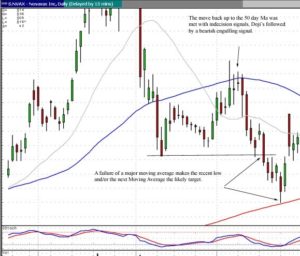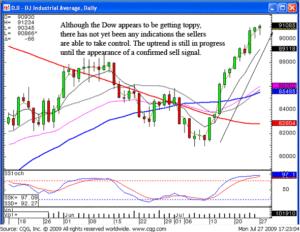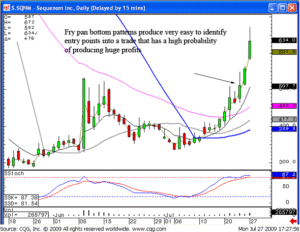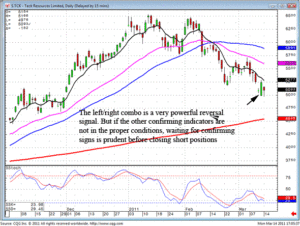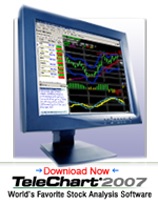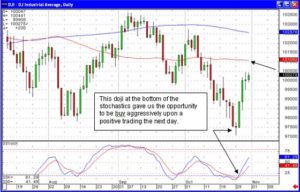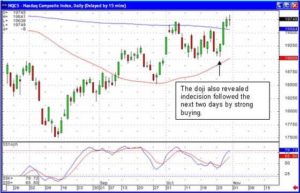Ask Price
The price at which a seller is offering to sell an option or stock.
Assignment
The receipt of an exercise notice by an option writer (seller) that obligates him to sell (in the case of a call) or purchase (in the case of a put) the underlying security at the specified strike price.
At-the-money
An option is at-the-money if the strike price of the option is equal to the market price of the underlying security.
Automatic Exercise
A protection procedure whereby the Options Clearing Corporation attempts to protect the holder of an expiring in-the-money option by automatically exercising the option on behalf of the holder.
Bearish
An adjective describing an opinion or outlook that expects a decline in price, either by the general market or by an underlying stock, or both.
Bear Spread
An option strategy that makes its maximum profit when the underlying stock declines and has its maximum risk if the stock rises in price. The strategy can be implemented with either puts or calls. In either case, an option with a higher striking price is purchased and one with a lower striking price is sold, both options generally having the same expiration date.
Beta
A measure of how a stock’s movement correlates to the movement of the entire stock market. The Beta is not the same as volatility.
Bid Price
The price at which a buyer is willing to buy an option or stock.
Box Spread
A type of option arbitrage in which both a bull spread and a bear spread are established for a near-riskless position. One spread is established using put options and the other is established using calls. The spread may both be debit spreads (call bull spread vs. put bear spread) or both credit spreads ( call bear spread vs. put bull spread). Break-Even Point–the stock price (or prices) at which a particular strategy neither makes nor loses money. It generally pertains to the result at the expiration date of the options involved in the strategy. A “dynamic” break-even point is one that changes as time passes.
Bullish
Describing an opinion or outlook in which one expects a rise in price, either by the general market or by an individual security.
Bull Spread
An option strategy that achieves its maximum potential if the underlying security rises far enough, and has its maximum risk if the security falls far enough. An option with a lower striking price is bought and one with a higher striking price is sold, both generally having the same expiration date. Either puts or calls may be used for the strategy.
Butterfly Spread
An option strategy that has both limited risk and limited profit potential, constructed by combining a bull spread and a bear spread. Three striking prices are involved, with the lower two being utilized in one spread and the higher two in the opposite spread. The strategy can be established with either puts or calls; there are four different ways of combining options to construct the same basic position.
Call
An Option contract that gives the holder the right to buy the underlying security at a specified price for a certain, fixed period of time.
Cash-Based
Referring to an option or future that is settled in cash when exercised or assigned. No physical entity, either stock or commodity, is received or delivered.
Cash Settlement
The process by which the terms of an option contract are fulfilled through the payment or receipt in dollars of the amount by which the option is in-the-money as opposed to delivering or receiving the underlying stock.
CBOE
The Chicago Board Options Exchange; the first national exchange to trade listed stock options.
Class
A term used to refer to all put and call contracts on the same underlying security.
Closing Purchase
A transaction in which the purchaser’s intention is to reduce or eliminate a short position in a given series of options.
Closing Sale
A transaction in which the seller’s intention is to reduce or eliminate a long position in a given series of options.
Closing Transaction
A trade that reduced an investor’s position. Closing buy transactions reduce short positions and closing sell transactions reduce long positions.
Combination
Any position involving both put and call options that is not a straddle.
Cover
To buy back as a closing transaction an option that was initially written.
Covered
A written option is considered to be covered if the writer also has an opposing market position on a share-for-share basis in the underlying security.
Covered Call
An option strategy in which a call option is written against long stock on a share-for-share basis.
Covered Call Option Writing
A strategy in which one sells call options while simultaneously owning an equivalent position in the underlying security or strategy in which one sells put options and simultaneously is short an equivalent position in the underlying security.
Covered Put Write
A strategy in which one sells put options and simultaneously is short an equal number of shares of the underlying security.
Covered Straddle
An option strategy in which one call and one put with the same strike price and expiration are written against 100 shares of the underlying stock.
Cycle
The expiration dates applicable to various classes of options. There are three cycles: January/April/July/October, February/May/August/November, and March/June/September/ December.
Return to Options Trading Main Page
If you did not find the term you were looking for here, you might try the CBOE Chicago Board Options Exchange. They have a broad selection of option terms and trading tools.
